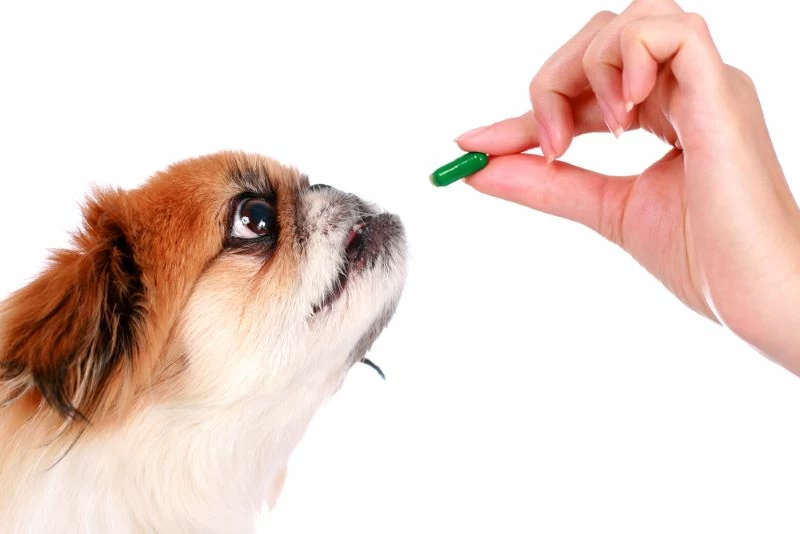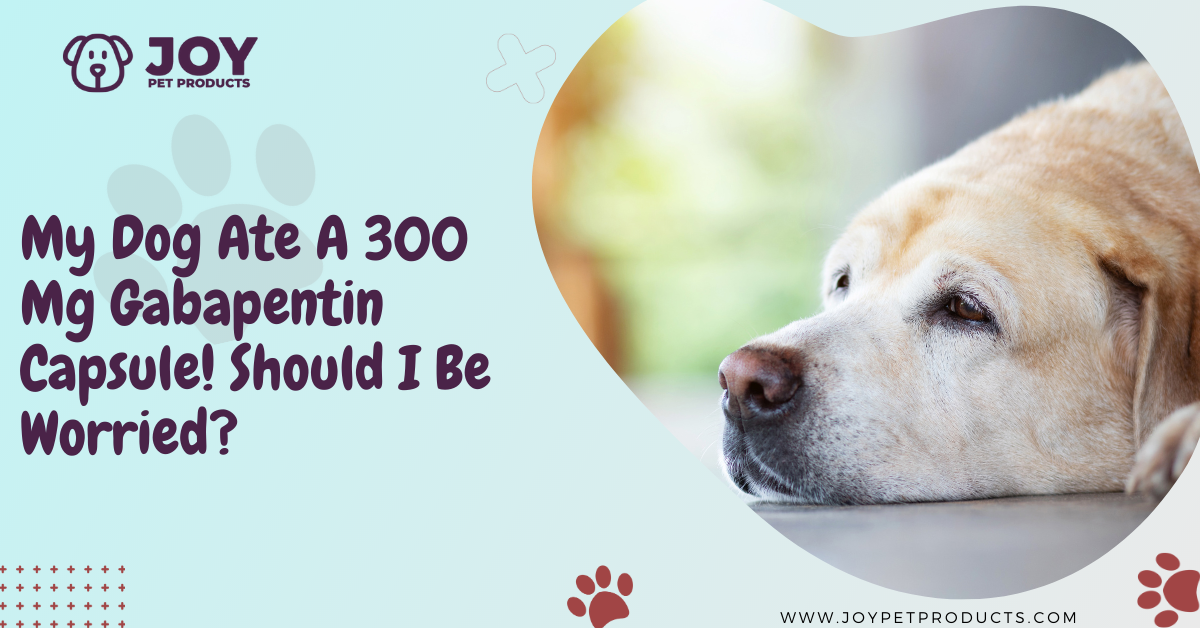If today is the fateful day that you’ve found yourself crying out, “My dog ate a 300 mg gabapentin pill!” (oddly specific, I know):
You need to understand that the drug can have very dire consequences for your best pal, depending primarily on their size and any sensitivities or pre-existing conditions they might have.
Symptoms of a toxic gabapentin overdose in canines can include diarrhea and vomiting, weakness, tremors, lethargy, incoordination, and seizures.
It is important that if you do see these signs in your dog that you take it to the vet immediately for treatment.
This will typically involve procedures such as induced vomiting, administration of activated charcoal, or stomach pumping– as long as the ingestion was caught early enough.
Read on below to learn exactly what gabapentin is, what it is used for, how it is metabolized, and how long the medication stays in a dog’s system!
What Happens If My Dog Eats A 300 Mg Gabapentin?

Let’s cut straight to the chase: Your dog can become seriously ill– and can even be at risk of death- if he’s recently eaten a 300 mg gabapentin capsule that he’s not supposed to.
Gabapentin (an amino acid that resembles a molecule known as GABA) is a neurotransmitter inhibitor that is commonly prescribed both in humans and in animals to control anxiety, chronic pain, and to treat seizures. It is frequently seen as sold under the brand name Neurontin.
Prescribed gabapentin is available in a variety of dosages, including 100mg, 300mg, 400mg capsules and 600mg and 800mg pills.
Gabapentin is often combined by vets with other types of pain medications, such as opioids and Non-Steroidal Anti-inflammatory (NSAIDs) medicines like Motrin.
Gabapentin is thought to work by binding to certain channels in the brain and thus inhibiting the release of specific neurotransmitters in the nervous system that can cause seizures.
Pre-existing medical conditions such as:
- Lung disease,
- Kidney disease, or being on dialysis (since gabapentin is excreted by the kidneys,
- Diabetes,
- Depression,
- Liver disease, or
- Heart disease
are all contraindications to the use of gabapentin.
Therefore, you need to be extra aware and careful if your dog does have any of these conditions as the ingestion of gabapentin can result in rapid worsening of these diseases.
Allergic effects of gabapentin in dogs include:
- Hives
- Shortness of breath
- Swelling of the face, tongue, and throat.
Clinical signs of a toxicity reaction in your dog include:
- Weakness
- Dizziness
- Diarrhea
- Vomiting
- Tremors
- Seizures
- Mild sedation
- Mild to moderate incoordination
- A gait or walking pattern which is unsteady.
What Is The Proper Gabapentin Dosage For Dogs?

A typical recommended dose of gabapentin for an average-sized (30 pound) dog is anywhere from 1.5 mg-10mg per pound of body weight in a 8 to 24-hour period.
The exact dosage will depend on the intended purpose of administration, whether that be for pain management or for treating seizures.
If your dog has eaten a 300 mg gabapentin pill, it is therefore quite possible for it to be considered an overdose– especially if your pup is a small/toy breed.
Therefore, the first step when this has happened should be to immediately contact your vet for further emergency advice.
Your vet may advise you to try to induce vomiting in your dog if it has ingested the pill within a 30-minute window, and if it is still showing enough stability and coordination.
Induced vomiting is usually carried out through the use of 3% hydrogen peroxide, which is given at a dosage of one teaspoon for every 10 pounds of body weight.
The solution can be given straight into the dog’s mouth, though many pet owners find that their pooch will accept it more readily by soaking the liquid in bread or mixing it with milk.
After the dog has swallowed the hydrogen peroxide, allow it to exercise outside for around 10 minutes to let the solution get to work. As the solution starts bubbling, it should cause the dog to vomit. If it fails to work within 15 minutes, a second dose can be given.
If too much time has passed and you are advised to bring your dog in for emergency care instead, your vet may elect to pump your dog’s stomach to remove any remaining gabapentin.
Activated charcoal may also be given to your dog either orally or via a tube placed into the dog’s stomach with the purpose of absorbing any remaining gabapentin.
Activated charcoal has the excellent quality of being able to ensure that certain poisons aren’t absorbed by the body and are instead safely passed through excretion. This in turn lowers the concentration of the toxin in the dog’s bloodstream.
How Long Does Gabapentin Stay in A Dog’s System?

When discussing the question of how long gabapentin stays in a dog’s system, it is important to discuss the concept of “half-life” of drugs.
The half-life of a drug is the amount of time it takes for the level of the drug in the bloodstream to decrease by one half.
In dogs, the half-life of gabapentin ranges between 2 to 4 hours.
Once administered by mouth to a dog, Gabapentin is absorbed from the duodenum (which is the first segment of the small intestines) into the bloodstream.
After absorption from the duodenum into the bloodstream, the gabapentin blood level then rises to a peak state within one to two hours.
Gabapentin is then metabolized (broken down to smaller components) in the liver with these byproducts, and then excreted out of the body through the kidneys after approximately three or four hours after administration.
Gabapentin given intentionally as medication should never be stopped suddenly, as this could lead to a rebound effect and even more pain or an increased number of seizures.
I Accidentally Gave My Dog A Double Dose Of Gabapentin! How Much Gabapentin Is Safe For A Dog?

A major study published in 2017 addressed the use of different doses of gabapentin in the treatment of postoperative pain over the last 15 years.
The study’s authors looked at one hundred and twenty two randomized clinical trials with 8466 patients in which gabapentin was compared to a placebo in four different dosing strengths and intervals with many studies also including the concomitant 24 hour use of morphine.
They wanted to determine the most beneficial dose of gabapentin with the fewest side effects for patients being treated for post-surgical pain.
Doses of gabapentin administered ranged from a low of 0 to 350 mg to a high of more than 1050 mg.
The study’s investigators concluded that the patients who were in the highest dose subgroup did experience the most significant decrease in the amount of morphine needed to reduce their acute pain without major side effects.
Extrapolating these findings to the treatment of dogs with chronic pain with gabapentin, it is abundantly clear that gabapentin has a definitive role in the treatment of acute and chronic pain in humans.
Historically, it is also an effective pain medication in dogs, though it should be used judiciously with close monitoring of side effects. Here are a few different ways that gabapentin can be used in dogs:
Pain Relief
Gabapentin is a relatively inexpensive, easy-to-store medication and can be safely prescribed by a vet to treat painful conditions in dogs such as osteoarthritis, cancer, dental pain and neck and lower back pain.
In a study of the causes of pain in 240 dogs, it was found that 136 had no definitive diagnosis, 44 had a tear of the cruciate ligament in a knee, 18 had intervertebral disc disease in the back, 16 had spondylosis (age related wear and tear of the spinal discs).
Additionally, 16 had a subluxation (partial dislocation) of the patella, 8 had osteosarcoma (bone cancer), 8 had an elbow or hip dysplasia (when the hip socket does not fully cover the head of the hip bone) and others had a disc protrusion (a type of mild disc herniation) of the vertebra).
Gabapentin has also been used traditionally to treat chronic neuropathic pain (pain caused by damage to either the peripheral nerves, the spinal cord or the brain).
Chronic pain is usually treated with gabapentin at a dose of 1.4 to 6 mg per pound of body weight. Typically, gabapentin is given for chronic pain once per day.
If however the dog has become tolerant to a certain amount of gabapentin, the dosage may need to be increased.
The safety of the medication when used correctly is such that even in situations where a dog is undergoing anesthesia for an operation or procedure it is usually not necessary to discontinue gabapentin.
Anxiety Relief

Gabapentin has also been found useful to treat anxiety in dogs by itself and in conjunction with other medications such as Prozac or Clomicalm ( a tricyclic antidepressant).
The goal of using gabapentin in dogs suffering from an anxiety disorder is to have them react less intensely to whatever is stressing them and it can often be used in conjunction with behavior modification treatment.
Usually, dogs suffering from anxiety are treated with gabapentin either one or two hours before an event which may trigger anxiety in a pet.
These may include routine visits to their vet, appointments with a groomer, long rides in the family vehicle, loud thunderstorms with lots of lightning, and events with fireworks such as the 4th of July or New Year’s Eve.
As already mentioned above, safe doses of gabapentin for a dog range from 5 to 30 mg/kg given from one to three times a day.
Generally, it is suggested that gabapentin should be started at the lowest possible dose and then titrated upwards over 7 to 10 day periods.
Treatment Of Seizures
When gabapentin is given for the treatment of seizures in a dog, the dose is usually higher with a range from 4.5 mg to 13.6 mg per pound with administration either two or three times per day.
If a dog is chronically being medicated with gabapentin, baseline lab values should be obtained so that any toxic effects of gabapentin treatment can be monitored.
This includes obtaining hepatic (liver function) and renal (kidney function) levels, as well as a complete blood count, a serum (blood) chemistry level and a baseline urinalysis.
These blood tests should be obtained approximately 1 or 2 months after starting gabapentin and repeated at 6 and 12 month intervals.
Anytime you are giving gabapentin to your dog it should be under the supervision of your dog’s vet. If side effects of gabapentin are encountered, the dose can be reduced by one half. If severe side effects persist, it should be completely discontinued.
In Summary
If you have discovered that your dog ate a 300mg gabapentin, the subsequent course of action would be to establish whether you are dealing with an overdose situation.
The normal recommended dosage of gabapentin in dogs is anywhere from 1.5-10mg per pound of body weight. By doing a bit of quick math, you’ll be able to find out fairly quickly whether your pup is in any sort of danger!
Even if your dog has not overdosed based on the recommended dose guidelines, it could still be negatively affected by the medication in its system if it has pre-existing conditions such as kidney, liver, lung, or heart disease.
If you notice any symptoms such as incoordination, lethargy, inability to walk properly, vomiting, tremors, or seizures, take your dog to the vet immediately.
If you catch your dog in the act quickly enough, there may still be enough time for procedures such as induced vomiting, stomach pumping, and activated charcoal administration to minimize the impact the gabapentin has on the poor pooch.
Heather Abraham is a professional blogger who owns two dogs, a cat, a parrot, and a leopard gecko. She has a connection with animals since she was a child. She shares her love for all pet breeds and provides information on pet food, toys, medications, beds, and everything else.
She is committed to learning about the internal workings of animals. Her work permits her to work closely with knowledgeable vets and obtain practical expertise in animal care. When she is not working, her love of animals continues in her writing. Her goal is to educate and uplift readers who also have a passion for animals through her writing.
